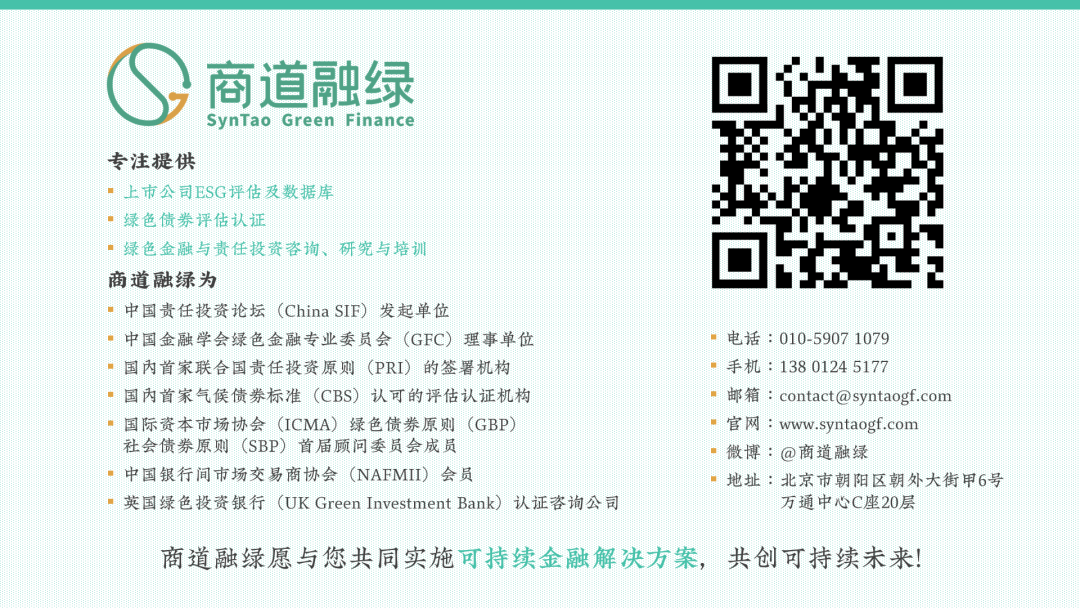Fueled by the “dual-carbon” goals, China fast-tracked its sustainable and responsible investment. China SIF has just released the Top 10 Trends in Responsible Investment in China for the third consecutive year and held webinars in English and Chinese on March 18 and 24 respectively. Both webinars were hosted by Ms. Grace Guan, Secretary-General of China SIF and Executive VP of SynTao Green Finance, with the following speakers: Dr. Guo Peiyuan, Chairman of China SIF and SynTao Green Finance, Dr. Sun Mingchun, Chief Economist of Haitong International, and Mr. Simon O'Connor, Chairman of Global Sustainable Investment Alliance, CEO of Responsible Investment Association Australasia (RIAA). The two webinars, in total, attracted close to 2,000 participants.
China SIF, together with SynTao Green Finance, published two reports. The China Sustainable Investment Review 2021, and the 2022 China Top 10 Trends in Responsible Investment, exhibited the development of responsible investment in China and presented the development trends for the coming year respectively. It is pointed out that even though the scale of responsible investment in China is relatively small compared to major markets in other regions, but the noticeable progress in policymaking, market penetration, and public awareness still marked a fruitful year for China. The green credit balance increased by more than RMB 2 trillion since the previous year, and the scale of both ESG mutual funds and green bonds has more than doubled. Green credit is the fastest-growing credit asset, and we believe the year 2022 will see the trend continue.
In the webinar, Dr. Guo shared his insights from three perspectives - policy dynamics, market momentum, and information disclosure. In terms of policy development, the introduction of the “dual-carbon” goals played an important guiding role in ESG and green finance development in China. The "1+N" policy framework laid out the overall principles, implementation roadmaps, supporting measures and ensuring system, setting a clear path leading to the realization of “dual-carbon” goals and an orderly transition. In addition, a series of supporting tools such as carbon-reduction supporting tools and special refinancing loans for clean and efficient use of coal became an essential part of the effort in leveraging the financial institutions to allocate the capital to green assets.
In terms of the market momentum, the overall size of responsible investment in China has increased to RMB 18 trillion, registering an annual growth of 30%. Long-term capital revealed a strong affinity towards ESG investing as well. In November 2021, China Investment Corporation (CIC) released its Sustainable Investment Policy and during the same month, the Insurance Asset Management Association of China (IAMAC) established an Expert Committee on Responsible Investment, in which Dr. Guo Peiyuan was invited as an expert advisor. The green bond has grown considerably in 2021, with innovative sustainable bond products continuously launched to the market. The Common Ground Taxonomy incorporates features and advantages of the respective green catalogues of China and Europe, marking a new chapter of China-Europe cooperation in green investment and financing, guiding cross-border climate investment and financing activities.
In 2021, China has been actively engaging in the G20 Sustainable Finance Working Group (G20SFWG), hosted the UN Biodiversity Conference in Kunming, established the Central Banks and Supervisors Network for Greening the Financial System (NGFS), and carried out the climate stress testing in a few pilot banks. These initiatives demonstrated China’s commitment and determination in international collaboration. In the talent market, the demands for ESG talents and ESG training have grown drastically. The headhunting and talent training business is emerging, and many visionary universities have opened or started to design ESG-themed courses and programs. In response to this trend, SynTao Green Finance has developed a mini-series of online courses to introduce the practices and heat topics of ESG.
In terms of information disclosure, the regulators are putting more focus on anti-greenwashing as the market for green finance and ESG investing is booming. Globally, the EU was the first to take the initiatives to introduce the Sustainable Finance Disclosure Regulation (SFDR). The SFC of Hong Kong has issued a Circular that imposed disclosure requirements on ESG funds. In August, the PBoC issued the Guidelines on Environmental Information Disclosure for Financial Institutions and began piloting environmental information disclosure in the banking sector and carbon accounting for financial institutions in some areas. Towards the end of the year, the PBoC organized a round of climate environment stress tests. These measures indicated the tendency of regulators to rein in greenwashing risks, and it is clear for the financial institutions that they must disclose their information in more practical, calculable, and verifiable means for the future.
For listed companies, the China Securities Regulatory Commission (CSRC) declared that they would enforce the policy at a steady pace. Starting with the Shanghai Stock Exchange (SSE) and Shenzhen Stock Exchanges (SZSE) updating their listing rules and reiterating that listed companies shall disclose the ESG or CSR reports, followed by the proposal from the revised draft of the Company Act stating that companies are encouraged to publish CSR or ESG reports, it is foreseeable that ESG information disclosure will become a common practice for listed companies and large enterprises in China.
In the Chinese webinar, Dr. Sun Mingchun, Chief Economist of Haitong International believed that there were three main drivers behind the rapid growth of social responsible investment in China in the past three years: The pandemic made many companies conscious of their social responsibility and urged them to take practical actions to contribute to society; The “dual-carbon” goals proposed in the 14th Five-Year Plan represented a major breakthrough for responsible investment; And the goal of common prosperity also brought companies' attention to their relationship with employees and society.
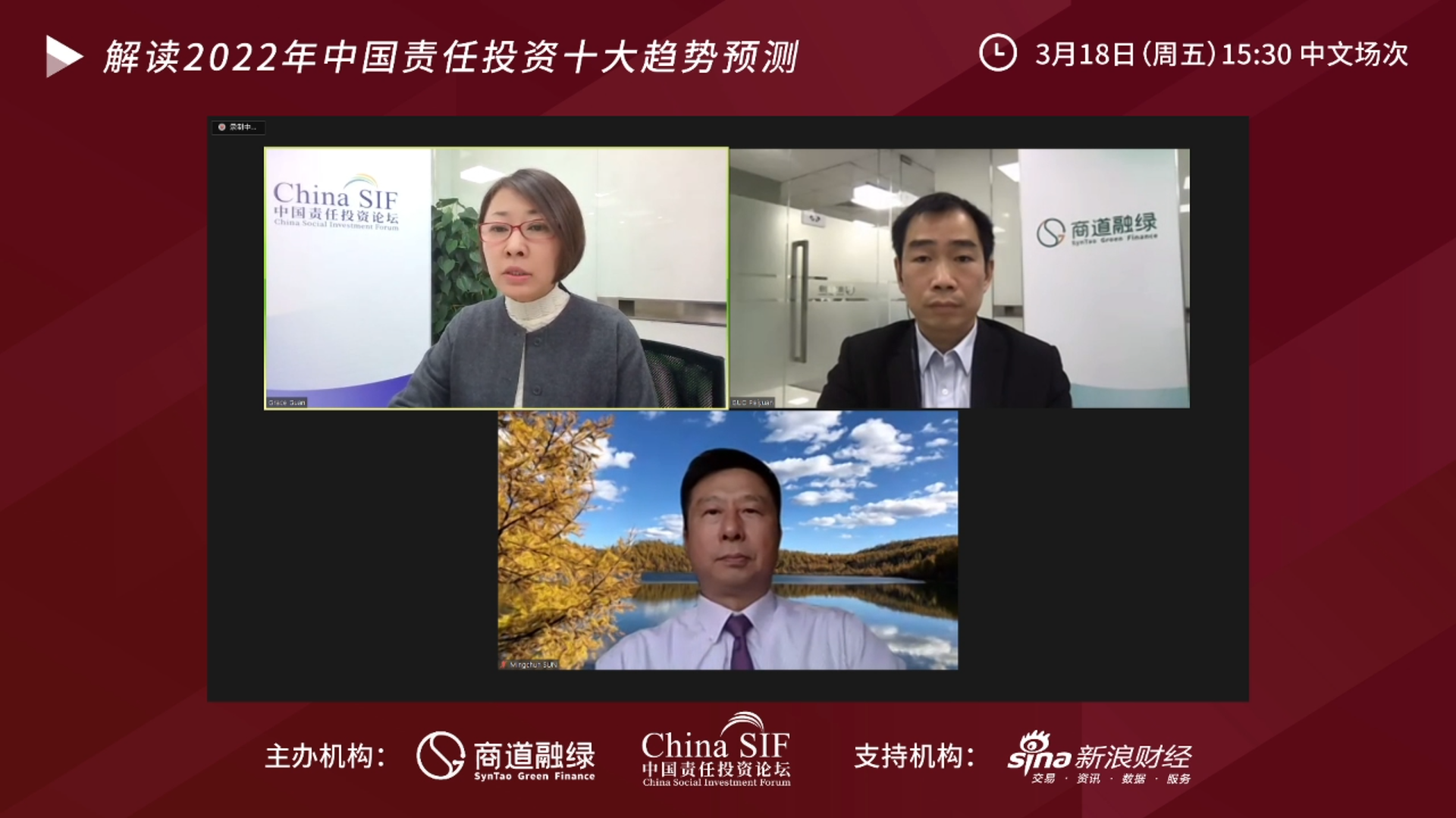 At the same time, Dr. Sun appreciated the synergy of all parties to contribute to a prosperous ESG investing ecosystem in China. As the booming third-party service providers rolled out services such as data, rating, and certification to meet the growing demand from the interested investors, the regulators also released multiple documents to regulate the market. However, the core of ESG development still lies in companies. In the end, the purpose of ESG principles is for the companies to better manage their business and be responsible corporate citizens. Dr. Sun said that he will continue to pay close attention to responsible investment development in China, as he saw it as a social experiment of great significance.
In the English webinar, Simon O’Connor, the Chair of Global Sustainable Investment Alliance, CEO of Responsible Investment Association Australasia, commented on the ten trends from a global perspective. He shared that it was fascinating to see the scale and momentum of responsible investment in China, and there are many themes that are consistent in what is being seen in global trends, from the push for better disclosures to strong regulatory developments, through to rising green finance off the back of strong net-zero commitments. Simon cited global developments in rising standards of ESG and climate disclosures, such as a recent release by the US Securities and Exchange Commission (SEC) proposing draft climate disclosure requirements, as well as the broad influence across markets of the rising standards being set by EU regulators. More and more countries are starting to see regulatory and policies progress to lift standards to catch up with the global wave. In many markets outside of China, retail investor demand has also become a very strong driving force behind the growing market.
At the same time, Dr. Sun appreciated the synergy of all parties to contribute to a prosperous ESG investing ecosystem in China. As the booming third-party service providers rolled out services such as data, rating, and certification to meet the growing demand from the interested investors, the regulators also released multiple documents to regulate the market. However, the core of ESG development still lies in companies. In the end, the purpose of ESG principles is for the companies to better manage their business and be responsible corporate citizens. Dr. Sun said that he will continue to pay close attention to responsible investment development in China, as he saw it as a social experiment of great significance.
In the English webinar, Simon O’Connor, the Chair of Global Sustainable Investment Alliance, CEO of Responsible Investment Association Australasia, commented on the ten trends from a global perspective. He shared that it was fascinating to see the scale and momentum of responsible investment in China, and there are many themes that are consistent in what is being seen in global trends, from the push for better disclosures to strong regulatory developments, through to rising green finance off the back of strong net-zero commitments. Simon cited global developments in rising standards of ESG and climate disclosures, such as a recent release by the US Securities and Exchange Commission (SEC) proposing draft climate disclosure requirements, as well as the broad influence across markets of the rising standards being set by EU regulators. More and more countries are starting to see regulatory and policies progress to lift standards to catch up with the global wave. In many markets outside of China, retail investor demand has also become a very strong driving force behind the growing market.
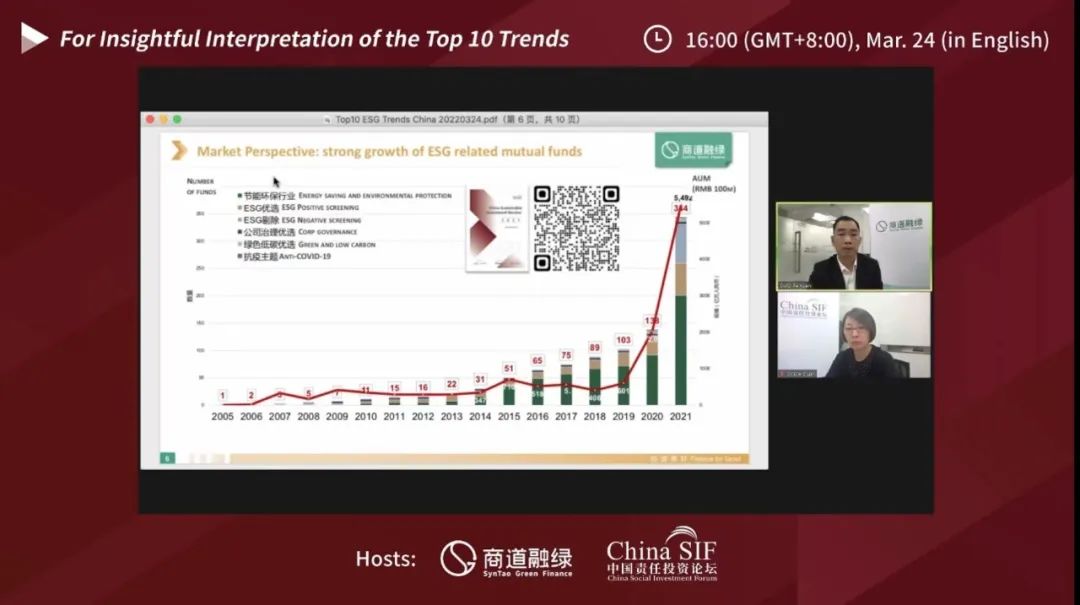
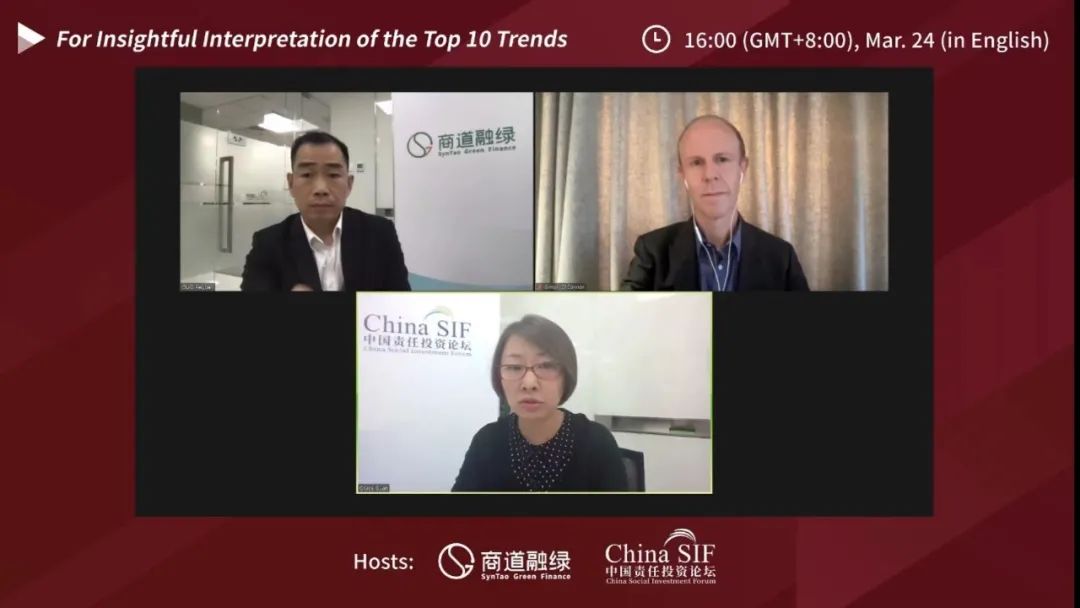
At the end of the two webinars, the audience raised many valuable questions on how to verify green assets for financial institutions, how to practice ESG information disclosure for private companies and how to conduct transition finance. A lively discussion concluded the webinars.
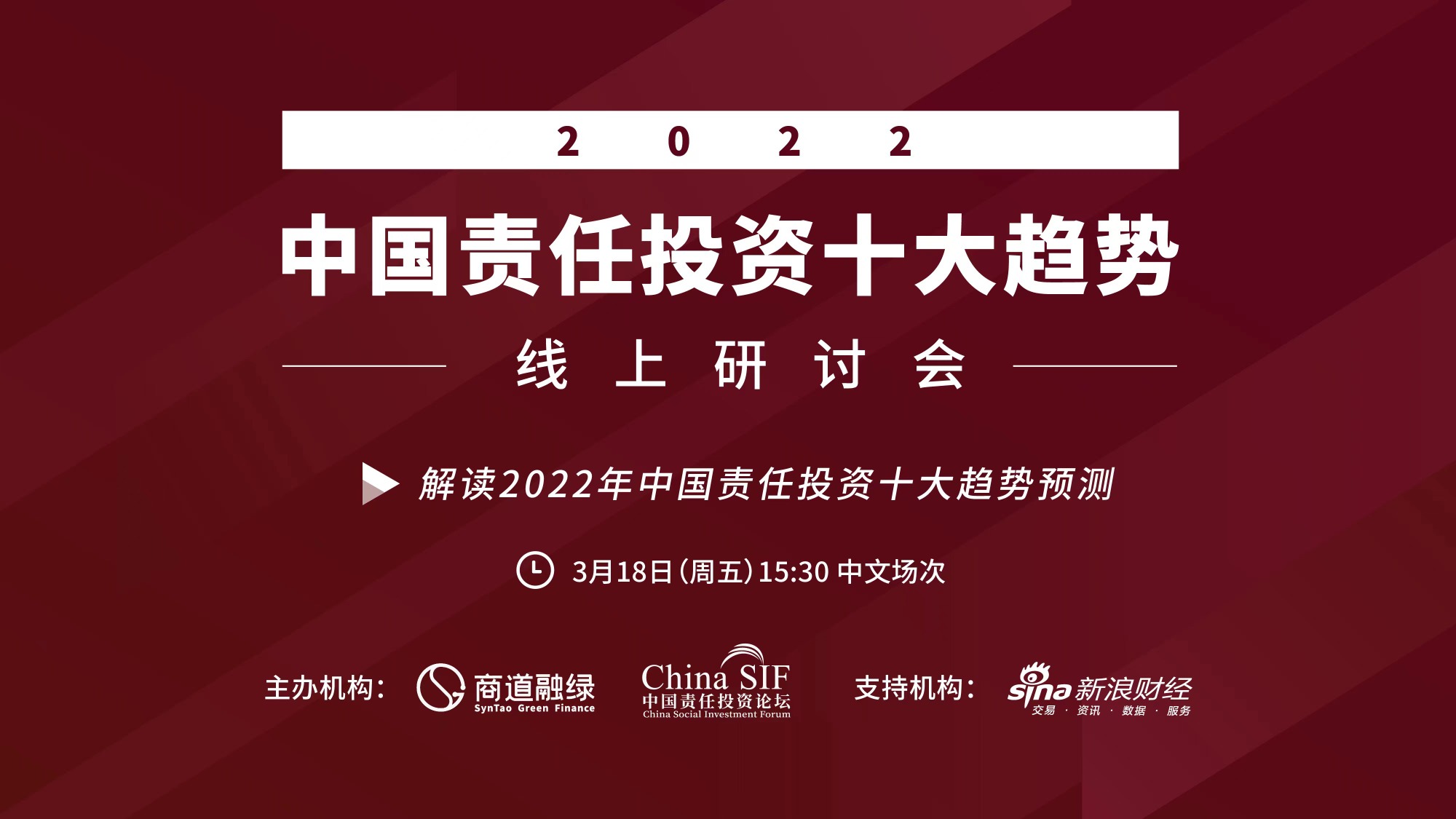
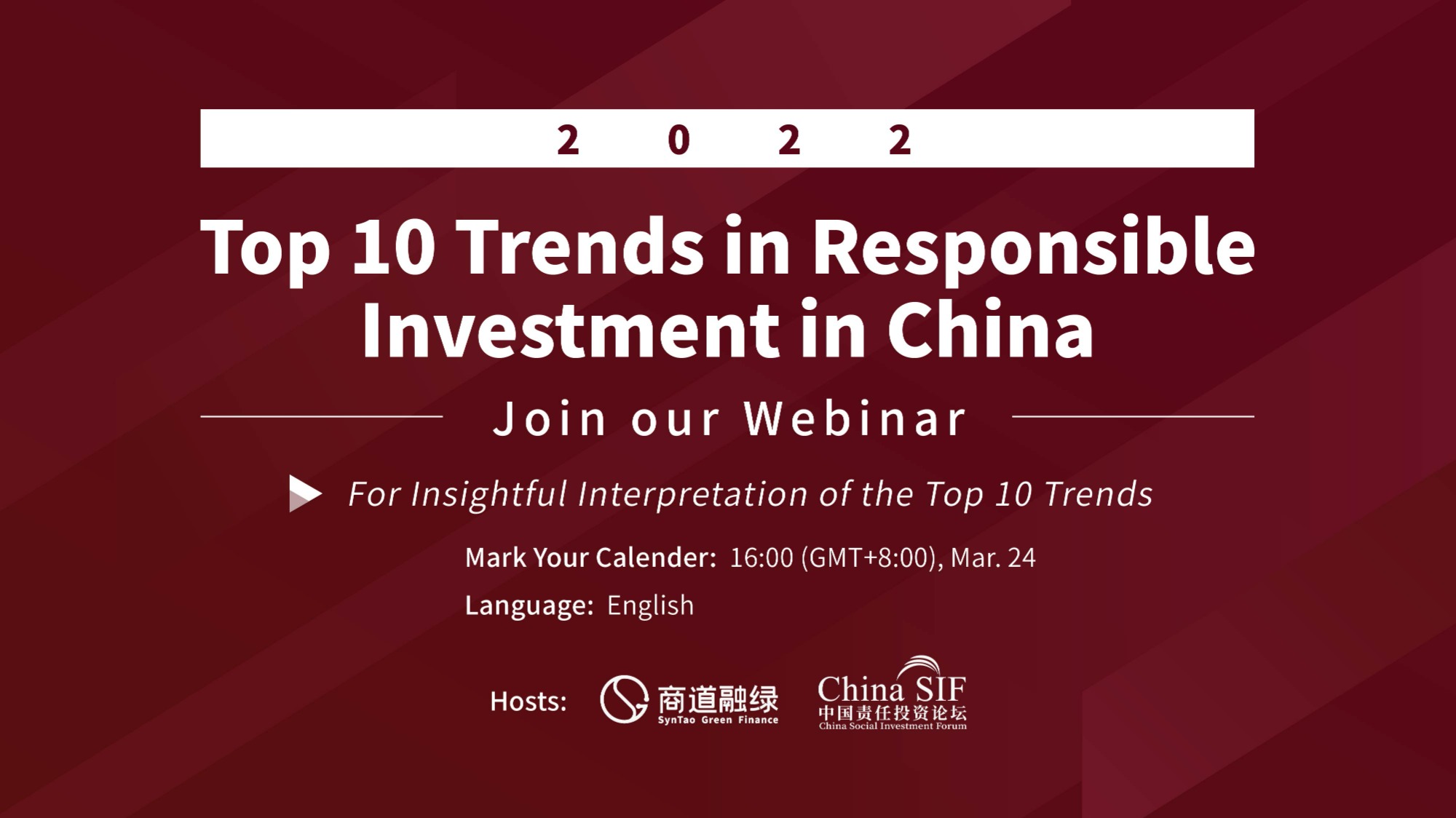
Links to download related materials (in English and Chinese):
China Sustainable Investment Review 2021
https://en.chinasif.org/products/csir2021
Top10 Trends in Responsible Investment in China 2022
https://en.chinasif.org/products/2022top10
For the PPTs used in this webinar
Please email us at:contact@chinasif.org, we will get back to you as soon as possible.
Click HERE for playback.
